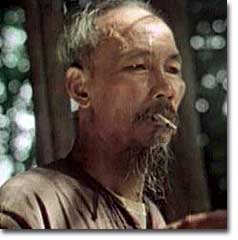55a. Early Involvement

Ho Chi Minh's resistance to colonial powers in Indochina led to the formation of the Marxist liberation movement known as the Viet Minh. The United States provided financial support to France's fight against Ho Chi Minh and the Viet Minh from the 1940s until direct U.S. involvement.
While Americans were girding to fight the Civil War in 1860, the French were beginning a century-long imperial involvement in Indochina. The lands now known as Vietnam, Laos, and Cambodia comprised Indochina. The riches to be harvested in these lands proved economically enticing to the French.
After World War I, a nationalist movement formed in Vietnam led by Ho Chi Minh. Ho was educated in the West, where he became a disciple of Marxist thought. Ho resented and resisted the French. When the Japanese invaded Vietnam during World War II, they displaced French rule. Ho formed a liberation movement known as the Viet Minh. Using guerrilla warfare, the Viet Minh battled the Japanese and held many key cities by 1945. Paraphrasing the Declaration of Independence, Ho proclaimed the new nation of Vietnam — a new nation Western powers refused to recognize.
France was determined to reclaim all its territories after World War II. The United States now faced an interesting dilemma. American tradition dictated sympathy for the revolutionaries over any colonial power. However, supporting the Marxist Viet Minh was unthinkable, given the new strategy of containing communism.
Domino Theory
American diplomats subscribed to the domino theory. A communist victory in Vietnam might lead to communist victories in Laos, Cambodia, Thailand, Malaysia, and Indonesia. Such a scenario was unthinkable to the makers of American foreign policy.
President Truman decided to support France in its efforts to reclaim Indochina by providing money and military advisers. The United States financial commitment amounted to nearly $1 billion per year.
The French found Ho Chi Minh a formidable adversary. Between 1945 and 1954 a fierce war developed between the two sides. Slowly but surely, the Viet Minh wore down the French will to fight. On May, 8th, 1954 a large regiment of French troops was captured by the Vietnamese led by communist general Vo Nguyen Giap at Dien Bien Phu.
A Nation Divided
The rest of the French troops withdrew, leaving a buffer zone separating the North and South. Negotiations to end the conflict took place in Geneva. A multinational agreement divided Vietnam at the 17th parallel. The territory north of this line would be led by Ho Chi Minh with Hanoi its capital.
The southern sector named Saigon its capital and Ngo Dinh Diem its leader. This division was meant to be temporary, with nationwide elections scheduled for 1956. Knowing that Ho Chi Minh would be a sure victor, the South made sure these elections were never held.
During the administrations of Eisenhower and Kennedy, the United States continued to supply funds, weapons, and military advisers to South Vietnam. Ho Chi Minh turned North Vietnam into a communist dictatorship and created a new band of guerrillas in the South called the Viet Cong, whose sole purpose was to overthrow the military regime in the South and reunite the nation under Ho Chi Minh.
The United States was backing an unpopular leader in Ngo Dinh Diem. Diem was corrupt, showed little commitment to democratic principles, and favored Catholics to the dismay of the Buddhist majority. In November 1963, Diem was murdered in a coup with apparent CIA involvement.
Few of Ngo's successors fared any better, while Ho Chi Minh was the Vietnamese equivalent of George Washington. He had successfully won the hearts and minds of the majority of the Vietnamese people. Two weeks after the fall of Diem, Kennedy himself was felled by an assassin's bullet.
By the time Lyndon Johnson inherited the Presidency, Vietnam was a bitterly divided nation. The United States would soon too be divided on what to do in Vietnam.






